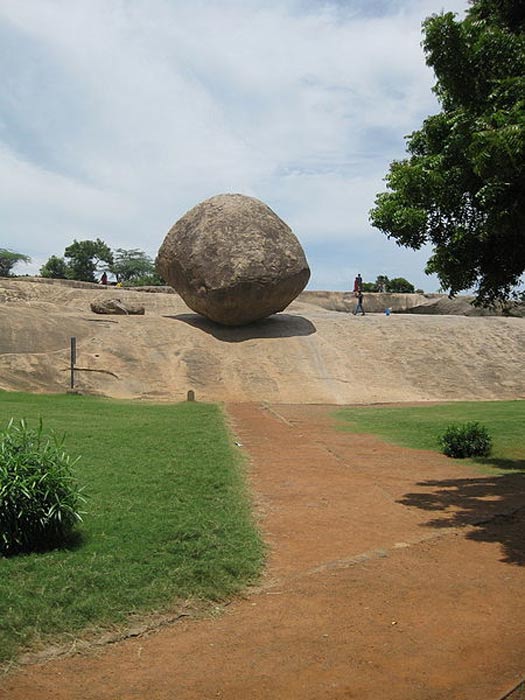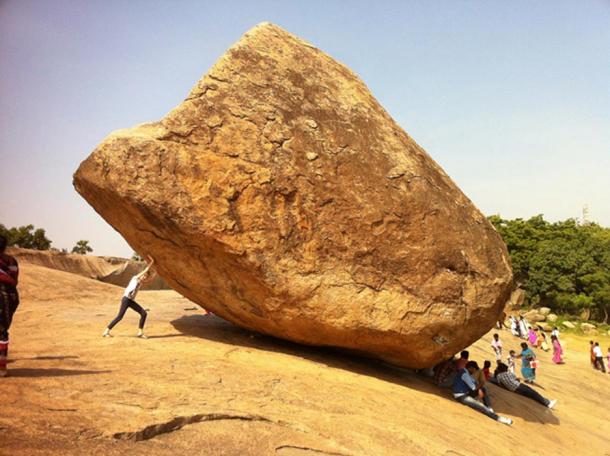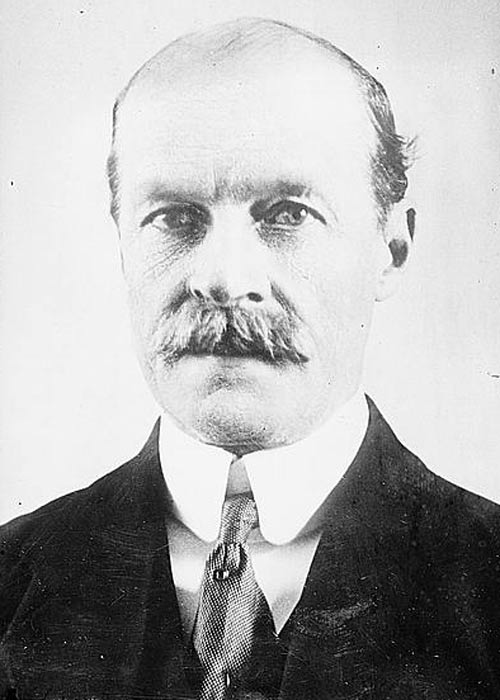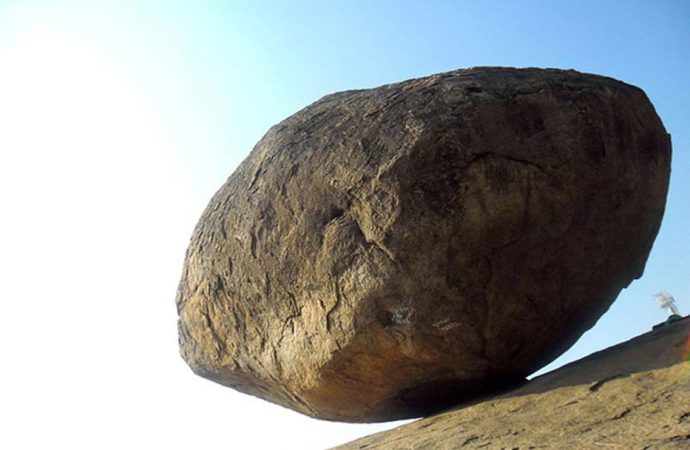This giant boulder is one of the town Kancheepuram’s tourist attractions, as it seems to defy the laws of physics.
The Krishna Butter Ball is a large boulder located in Mahabalipuram, a town in the Kancheepuram district in the southern Indian state of Tamil Nadu. This giant boulder is one of the town’s tourist attractions, as it seems to defy the laws of physics. This rock seems to be balancing off a small surface area on the slope of a hill. It has neither slid down this hill, nor budged when attempts were made to move it. There are a number of stories that seek to explain how this unusual phenomenon is possible, though none of them seem to have answered the question satisfactorily.
Butter Ball History
Krishna’s Butter Ball was originally known to the locals as Vaan Irai Kal. Translated from Tamil to English, it means ‘Stone of the Sky God’. This name provides one tale as to how this boulder came into being. According to one explanation, it was the gods who placed this boulder in Mahabalipuram. The purpose of doing so was to show the might and power of the gods to the inhabitants of that town. A more modern explanation substitutes the gods with extra-terrestrials who visited the area thousands of years ago.
According to some sources, the ‘Stone of the Sky God’ became known as Krishna’s Butter Ball as a result of a local tour guide’s ‘re-branding’ of the boulder. According to Hindu mythology, the god Krishna, as a child, was fond of eating butter, and would often steal handfuls of that food from his mother’s butter jar. As the giant boulder at Mahabalipuram looked like a dollop of butter that the god had dropped, it was conveniently given the name Krishna’s Butter Ball. This name has stuck ever since.
![Krishna with cows, herdsmen and Gopis, Pahari painting [Himalayan] from Smithsonian Institution.](http://www.ancient-origins.net/sites/default/files/styles/large/public/Krishna-with-cows.jpg?itok=c4fpqbKE)
Krishna with cows, herdsmen and Gopis, Pahari painting [Himalayan] from Smithsonian Institution. ( Public Domain )
Boulder Formation
Krishna’s Butter Ball is estimated to weigh over 250 tons, and measures about 6 m (19.6 ft.) in height and 5 m (16.4 ft.) in diameter. This boulder sits on a 45 degree slope, and comes into contact with the surface of the hill only at an extremely small area. Despite being in such a precarious position, the giant boulder has not rolled off the hill. One speculation is that the rock was formed naturally. Nevertheless, this is rather unlikely, as corrosion would not have produced a boulder shaped like this. One face of the rock is entirely sheared off, making is improbable that it was the work of natural forces.

Krishna’s butter ball at Mahabalipuram. ( CC BY-SA 3.0 )
Moving Attempts
Attempts have also been made over the centuries to move Krishna’s Butter Ball, though to no avail. One of the earliest known attempts is said to have been made during the time of Narasimhavarman, a Pallava king who reigned during the 7 th century AD. Apparently, the king wanted to move the divine rock so that he could save it from the hands of sculptors. In spite of his good intentions, the boulder would not budge, and the king had to give up his plans.

A person trying to move the boulder (Flickr/CC BY-NC-SA 2.0 )
Another known attempt to move the stone was made during the early 20 th century. It is recorded that in 1908, the Governor of Madras, Arthur Lawley, intended to have the boulder removed from the hill. This was because he feared that it would roll down at any time, and destroy the town that stood at the base of the hill.

Photo shows Arthur Lawley, 6th Baron Wenlock (1860-1932) ( Public Domain )
It is said that seven elephants were used during the undertaking, though the rock did not budge even a little. The governor’s fears have proven to be unfounded, as Krishna’s Butter Ball has not moved in the last 100 years, let alone roll down the hill. Thus, the town remains safe from its destruction, for the time being.
Inspiration
Krishna’s Butter Ball served as the inspiration behind the creation of the ‘Tanjavur Bommai’. This is a type of traditional Indian roly poly toy made of terracotta. The Raja Raja Chola, who reigned between the late 10 th and early 11 th centuries AD, was inspired by the boulder, and thus created this toy. Today, Krishna’s Butter Ball is one of Mahabalipuram’s popular tourist attractions.
Source: Ancient Origins

































Leave a Comment
You must be logged in to post a comment.